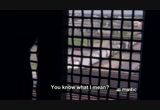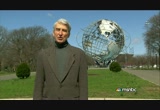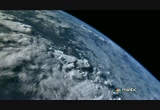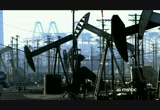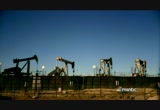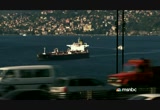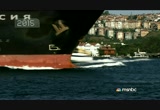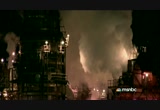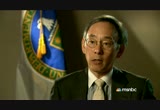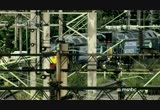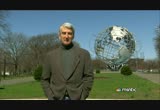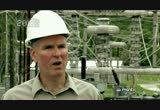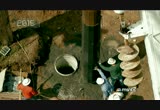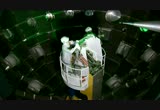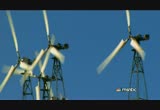tv Future Earth Addicted to Power MSNBC December 2, 2012 3:00am-4:00am PST
3:00 am
thinking and go crazy in cell. you can't do much but make the best of it, you know what i mean. i've got to be stronger, you know what i mean? a ship carrying gas explodes in boston harbor. a chinese dam collapses, unleashing a 50-foot tidal wave. the east coast is plunged into days of darkness by a blackout. and in london, a train carrying nuclear waste crashes.
3:01 am
enveloping the city in a radioactive cloud. these nightmare scenarios could happen. because we have become addicted to energy. and like any addict, we don't care how we get our fix. but now the consequences could lead to global disasters. ♪ addicted to power. we are. across this globe of ours, the race is on to plug the growing gap between diminishing energy supply and soaring demand. meanwhile, to avoid choking on the carbon-based energy we burn,
3:02 am
we're engaged in a worldwide search. not a gold rush but a power rush to be the first to find and first to develop new energy sources that are clean, green, and, yes, in expensive. >> what will happen to the world 100 years from today is actually fundamentally quite frightening. many people don't appreciate just how frightening it is, so we need a new industrial revolution. >> america's secretary of energy, professor steven chu, is a nobel prize-winning physicist. he deals in science fact. >> we had incredible energy sources so we built an infrastructure, and instead of habits based on abundant energy for 200 years. >> rapid global industrialization has helped create global prosperity. but it is also addicted the world to fossil fuels now poisoning and warming our planet.
3:03 am
in the next 20 years, we'll need 60% more power to satisfy the new emerging global economy. but what will be the source of that new power? foss ilg fuels? nuclear? hydro electric? each has advantages and risks. >> our generation's response to this challenge will be judged by history. for if we fail to meet it boldly, swiftly and together, we risk consigning future generations to an irreversible catastrophe. >> oil is the fossil fuel that drives the world's economy. oil is black gold. dirty but precious. the world is hooked. >> you look back at the history of the 20th century.
3:04 am
in some ways, it is the history of oil. it's been a driver of geopolitics. it's been a driver of military policy for a lot of countries. and it has at the same time -- it has been sort of the fuel for the engine of economic growth. >> the u.s. is a society built on oil. transport, commerce, food, medicine. all inextricably linked to oil with a huge trillion-dollar infrastructure built to support it. but the world's oil reserves are fast running out. we may already have passed the peak of production. our reliance on oil also makes it a potent political tool. one used in the past and most likely to be used again in the future.
3:05 am
the u.s. government adviser and global energy security expert paul understands the dangers. >> we remain hostage to a relatively wide range of possibilities for oil to be disrupted, any of which could cause problems with world trade or even cause economic growth to come to a halt. >> disruption of supply by accidents and even terrorist attacks is now the global economy's achilles' heel. 80% of the world's oil passes in oil tankers through six narrow shipping channels, also known as choke points. the strait in turkey connects russia, the world's second biggest oil exporter with the rest of the world.
3:06 am
>> it could cause an oil shock wave globely. if the bosphorus was closed, 7% of the oil of the world would cease to be shipped. >> disruption of oil supply could throw the world into turmoil. turkey, 2015. a tanker loaded with 150,000 tons of russian crude oil. navigates through the bosporou is which is at its narrowest point 2 rkds 200 feet woods. iran, russia's main competitor, is suspicious with russia's links with the west and oil deals in the caspian sea. a terrorist group plows a boat into the russian tanker.
3:07 am
the sunken tanker blocks the bosforous to all traffic. oil markets react instantly to the news. >> as soon as the bosphorus is closed, oil prices will rise immediately. >> but there's worse news. africa's biggest oil producer, nigeria, is in turmoil after election results are contested. >> oil has been systematically disrupted in nigeria for political gain for the entirety of the last decade. this disruption would provide an opportunity to amplify their disruptions. >> nigerian militants capitalize on the boss for russ oil market collapse by disrupting the oil wells, another 5% of the global
3:08 am
supply is lost. with 12% of oil supplies disrupted, prices spiral out of control. after just three days, motorists begin panic-buying gasoline. people are forced to seek other means of transport as oil prices increase, truckers protest, block aiding roads. but the price keeps rising. >> we could be well above 130, $140 by the end of it. those are the kinds of prices that triggered the last recession. >> it takes four weeks to reopen the bosphorus. it's already too late. the world plunges into global recession. >> is the united states prepared to deal with another oil shock? the answer is no. is the world economy prepared to deal with another oil shock? the answer is no. >> until we can develop alternative fuels for transportation, the world remains at the mercy of the oil markets.
3:09 am
weaning ourselves off fossil fuels is a slow and expensive business. but there is a fossil fuel that is relatively cheap and also plenty full. natural gas. but when i was in an accident... i was worried the health care system spoke a language all its own with unitedhealthcare, i got help that fit my life. so i never missed a beat. that's health in numbers. unitedhealthcare.
3:10 am
you can stay in and share something... or you can get out there and actually share something. ♪ the lexus december to remember sales event is on. this is the pursuit of perfection. i got your campbell's chunky soup. mom? who's mom? i'm the giants mascot. the giants don't have a mascot! ohhh! eat up! new jammin jerk chicken soup has tasty pieces of chicken with rice and beans. hmmm. for giant hunger!
3:11 am
3:12 am
our existing sources of energy are running out. and they are also polluting and warming our planet. are we heading for a crisis point? in an energy-starved world, natural gas is becoming an increasingly attractive alternative for generating energy. it emits half the carbon of coal and one-third the carbon of oil. demand for gas is growing. but in its gaseous state, it is
3:13 am
expensive to transport, so it is compressed 600 tons and then cooled, becoming a liquid gas, known as lng. one giant tanker can hold 36 million gallons of lng in pressurized tanks. enough to power a city like boston, massachusetts, for a week. but a tanker is extremely dangerous. lancashire, england, firefighters train for an lng accident. the freezing liquid doesn't burn. but as it pours out of a ruptured container, it vaporizes and spreads uncontrollably. now the gas cloud becomes highly volatile. once ignited, it burns at 2,300 degrees fahrenheit, twice as hot as gasoline.
3:14 am
>> if you have a large gas spill that ignited, what's going to start initially too close to the fire is the radiant heat, which you can feel on your face now. >> the surrounding air becomes so heated, firefighters can't get close. this is just a small training fire. an accident at a busy port would involve millions of gallons of lng. >> that would be a potential bomb. i would imagine it's a firefighter's worst nightmare, for something like that to happen in a harbor in the middle of a city. >> at present, there are 11 ports that handle lng tankers in the u.s. the one in boston is in the heart of the city. candace is an expert in maritime terrorism. her reform has revealed that lng
3:15 am
tankers could become a target for future terrorist attacks. >> the most likely scenario would be you would have an officer who would have quite a few years experience under his belt, familiar with the environments at sea, and has become radicalized and now has a suicide mission planned. >> a suicide mission in a city harbor would be catastrophic, affecting tens of thousands. m.i.t. professor and former chairman of the massachusetts port authority, james fay, published a report outlining the dangers of an lng explosion in boston harbor. >> you just have to look at the population of people out of doors in a space like this. anyone within a half mile of the
3:16 am
water fronlt could be hurt. >> 2015, boston harbor. a 1,000-foot tanker carrying lng sails at five knots into boston harbor, nearby downtown and logan airport, all densely populated. as is normal when an lng tanker approaches the harbor, no other traffic is allowed on the water. security is tight. >> helicopters are overhead. the roads are closed on the side. bridges are closed. there is a moving security cordon on either side of the vessel. >> but the massive security presence is looking the wrong way.
3:17 am
a radicalized crew member has planted a bomb next to one of the lng tanks. >> it doesn't take very much to blast a very big hole in the side of a tanker. >> the bomb's explosion splits the side of one of the tanks, and the lng pours out. it ignites, rupturing the other tank. >> once that occurred, then you're looking at what would be the most catastrophic thing, which would be a cascade failure of each of the tanks. >> thousands of tons of liquid gas pour into the water. >> the lng comes in contact with what it would regard as red-hot liquid. it is so cold compared to the water that it just turns into
3:18 am
vapor. >> the lng expands 600 times, as it vaporizes. wind carries the vast vapor cloud towards downtown boston. the cloud erupts in a fireball 1,000 feet high. a vast thermal radiation wave pulses through the city. this isn't fire but heat from the explosion, so hot that it ignites anything in its path. >> that circle identifies the region within which there would be harmful radiation to anyone on the shore. >> the gas would only burn for 15 minutes, but would be long enough to devastate the city. >> that's an enormous fire. we've never seen anything like that. and i hope we never do. >> but as long as lng is shipped into harbors like boston, the threat remains all too real. >> trying to run this kind of
3:19 am
business in old crowded ports where a lot of people live nearby has got to go. we've got to get the danger offshore, and then there's no problem. >> but while this would address the problem of safety, it does nothing to change the fact that gas is a fossil fuel and harmful to the environment. to address the growing need for cleaner energy, planners are going back to the future and are looking once more at nuclear power. when you give a child a toy, it has to work. ♪ make just one someone happy and when it's a toys for tots child, well, what could be more important? so this year, every hasbro toy donated to toys for tots will be powered by duracell. happy holidays. duracell with duralock. trusted everywhere.
3:21 am
to tell real people about our new 15 under $15 menu. oh my goodness! oh my gosh, this looks amazing! [ male announcer ] our new maine stays! 15 entrees under $15, seafood, chicken and more! oo! the tilapia with roasted vegetables! i'm actually looking at the wood grilled chicken with portobello wine sauce. that pork chop was great! no more fast food friday's! we're going to go to red lobster. yep. [ male announcer ] come try our new menu and sea food differently! and introducing 7 lunch choices for just $7.99.
3:22 am
3:23 am
only one of them has no carbon emissions. so i would, quite frankly, favor nuclear. >> it is estimated that over 500 nuclear plants in 30 countries will be in operation by 2025, despite the long shadows that hang over nuclear power. in 1979 a partial meltdown at the three mile island nuclear power plant in pennsylvania led to the release of radioactive gases. this in 1986 a disastrous accident in a soviet power plant at chernobyl led to the deaths of thousands. this confirms the worst fears of the anti-nuclear lobby. but the tide is turning. energy planners now believe the nuclear industry has learned its lessons. >> we now know how to operate nuclear power plants in a safe way.
3:24 am
the designs are far safer than the chernobyl and far safer actually than the three mile island design. >> but one problem persists. the safe disposal for the nuclear fuel rods, which remain lethal for centuries. >> if this rod had been just withdrawn from a reactor, it would be so intensely radioactive, my survival rate would be less than 1/30th of a second. >> john large is a world-renowned nuclear scientist. >> the insolved problem is the back end of the nuclear process. what do you do with the intensely radioactive fuel once it's served its purpose in the reactor? >> nuclear waste is transported in specially designed flasks that are tested to the limit.
3:25 am
tests like these prove the flasks could survive a 100-mile-an-hour train collision. they are designed to withstand a fire burning at 1,400 degrees fahrenheit for 30 minutes with water in the compartments. be b but according to john large, that could be their fatal flaw. >> i was concerned about the thermodynamic performance. it's in a fire, there's no way of planning for the damage that could occur. this flask is full of water, so it turns into a pressure cooker. >> such conditions could occur in a railway tunnel fire. july 18th, 2001, baltimore, maryland. population 600,000. a 60-car freight ran laden with flammable chemicals derails in
3:26 am
the howard street tunnel, resulting in an inferno. this physicist investigates what would have happened if nuclear flasks would have been involved in the tunnel fire. >> some of the cars were glowing reddish-orange. that would tell us that the fire would have to be around 1,500 degrees fahrenheit. >> nuclear waste flasks can withstand temperatures like that for only half an hour. the baltimore tunnel fire lasted five days. john large has calculated what could happen if such a disaster struck one of the world's biggest cities. london, england, 2015. spent nuclear fuel from a
3:27 am
reactor is en route to the world's largest reprocessing plant in england. it makes a routine rail journey through the heart of london. the train approaches a half-mile long tunnel north of the city center. in the darkness, a badly maintained track buckles, derailing the train. fortunately the protective flasks are intact. but before the train's crew can raise the alarm, a fright train laden with oil rumbles into the tunnel, plowing head-on into the derailed train. a spark ignites the spilled fuel.
3:28 am
the tunnel's brick walls act like a furnace. temperatures rise to 2,500 degrees fahrenheit. fire crews assess the radiation levels and know it is time to evacuate. >> the pressure builds up and builds up very rapidly at an hour and a half into the fire would be sufficient to break the flasks open and enable the fuel particles to be broken up and released into the atmosphere. >> even though only 1% of the radioactive fuel is likely to be released, it is all it takes to create a deadly plume over london.
3:29 am
the weather dictates the number of people exposed, which could be up to 700,000. there may not be any immediate deaths, but during the next 50 years, thousands of londoners could die as radioactive elements like plutonium lead to cancers. sooner or later, spent fuel now you stored on-site at u.s. nuclear plants will need to be moved, putting american cities at risk. yet the growing need to fill the energy gap has forced the nuclear option back on the table. >> i think nuclear power has to play a significant role. as we transition to renewables. it's going to take some time. i think it is a part of our mix. >> nuclear power could offer a
3:30 am
short-term solution. but could we harness the power from the rivers of the world to provide an endless clean source of energy? humans. even when we cross our t's and dot our i's, we still run into problems. namely, other humans. which is why at liberty mutual insurance, auto policies come with new car replacement and accident forgiveness if you qualify. see what else comes standard at libertymutual.com. liberty mutual insurance. responsibility. what's your policy? starts with arthritis pain and a choice. take tylenol or take aleve, the #1 recommended pain reliever by orthopedic doctors. just two aleve can keep pain away all day. back to the news. inspiration. great power. iconic design. exhilarating performance.
3:31 am
[ race announcer ] audi once again has created le mans history! [ male announcer ] and once in a great while... all of the above. take your seat in the incomparable audi a8. take advantage of exceptional values on the audi a8 during the season of audi event. ♪ till you finish your vegetables. [ clock ticking ] [ male announcer ] there's a better way... v8 v-fusion. vegetable nutrition they need, fruit taste they love. could've had a v8. or...try kids boxes! to bring you a low-priced medicare prescription drug plan. with a low $18.50 monthly plan premium, select generic hypertension drugs for only a penny and in-store copays as low as one dollar on other generic drugs after deductible, saving on your medicare prescriptions is easy. so you're free to focus on the things that really matter. call humana at 1-800-808-4003.
3:33 am
hey, there, i'm veronica dell a cruise. here's what's happening. the military officials say. the kansas city chief have decided go ahead with the game after the death of belcher. he killed his girlfriend and then went to the stadium and shot himts in front of his coach and manager. let's get you back to our program. our hunger for carbon-based energy is causing weather changes and altering the air we breathe. meanwhile, the earth warms, the poles melt, the oceans rise. but there is a green solution to our energy conundrum that
3:34 am
happens to be blue. water. by combining water and gravity, one gets an inexhaustible source of clean green energy, and it's available on every continent. hydro electric power. but the giant dams needed to hold back the water have an environmental cost, reducing the flow and damaging the ecosystem downstream. if a dam ever collapses, the death toll can be shocking. in 1975, a 50-foot wave killed 230,000 chinese when a dam failed. >> it was a typhoon that overwhelmed the dam. we've got to be able to anticipate those kind of storms and make sure that they're designed properly for those extreme loads, especially when you have extreme consequences. >> but despite the risks, china, argentina, congo, india, vietnam and mexico are all planning massive super dam projects.
3:35 am
this is western mexico. when it's complete, this hydroelectric dam on the santiago river will be one of the tallest in the world, more than 700 feet high. >> we are installing 750 mega watts of power here. enough to give energy for the city of guadalajara, which is 5 million people. >> ensuring the wall of water stays in place is the overwhelming priority for mendez. >> the factor of safety should be very, very high. we can't allow any minor
3:36 am
deficiency because honestly we have two more dams and it will work as a saskatchewan cade and it will be a disaster. >> engineers design dams to meet the most extreme conditions, like a rainstorm that might come only once in a thousand years. but global warming is forecast to make unpredictable weather more frequent and more extreme. experts now say the world's 45,000 large dams need to be upgraded to protect them from the effects of global warming or the consequences could be dire. china, 2015. the country leads the world in hydroelectric power generation. its population now 1.4 billion consumes more energy per day
3:37 am
than the united states in a week. its latest dam is built to withstand a one-in-1,000-year flood. an unprecedented category 5 typhoon strikes, unleashing 80 inches of rain in just 24 hours. debris carried by the rising water blocks the spillway. >> if the dam was not operated properly for the storm or if the spillway were clogged with debris, you can get more inflow than was ever anticipated. >> with the spillway blocked, the water level rises rapidly. a landslide crashes into the reservoir, releasing 5,000 tons of earth and rock. 800 million cubic feet of water
3:38 am
overtops the dam, sending a massive wave rolling down the hillside towards the villages beneath. further seven dams are breached by the waves as it sweeps downstream. whole communities are washed away. an area the size of los angeles is flooded. hundreds of thousands die. super dams can offer plentiful energy for many countries, but the unpredictable of future weather means there is an added pressure and risk. however our future energy is generated, it will all be for nothing if we can't get it from the power plant to where it's needed. it turns out that our power grid could be the weakest link of all in our future energy supply.
3:39 am
[ cat 1 ] i am not a vegetarian... look at these teeth! they're made for meat! [ cat 2 ] do i look like i'm stalking plants? [ male announcer ] most dry foods add plant protein, like gluten but iams never adds gluten. iams adds 50% more animal protein, [ cat 3 ] look at this body! under this shiny coat is a lean, mean purring machine [ cat 4 ] i am too! hahahaha! [ male announcer ] iams. with 50% more animal protein. [ cat 5 ] yum! [ cat 1 ] i'm an iams cat. feed me what i'm born to eat. meow. who have used androgel 1%, there's big news. presenting androgel 1.62%. both are used to treat men with low testosterone. androgel 1.62% is from the makers of the number one prescribed
3:40 am
testosterone replacement therapy. it raises your testosterone levels, and... is concentrated, so you could use less gel. and with androgel 1.62%, you can save on your monthly prescription. [ male announcer ] dosing and application sites between these products differ. women and children should avoid contact with application sites. discontinue androgel and call your doctor if you see unexpected signs of early puberty in a child, or, signs in a woman which may include changes in body hair or a large increase in acne, possibly due to accidental exposure. men with breast cancer or who have or might have prostate cancer, and women who are, or may become pregnant or are breast feeding should not use androgel. serious side effects however our future energy is possible increased risk of prostate cancer, lower sperm count, swelling of ankles, feet, or body, enlarged or painful breasts, problems breathing during sleep, and blood clots in the legs. tell your doctor about your medical conditions and medications, especially insulin, corticosteroids, or medicines to decrease blood clotting. talk to your doctor today about androgel 1.62% so you can use less gel.
3:41 am
log on now to androgeloffer.com and you could pay as little as ten dollars a month for androgel 1.62%. what are you waiting for? this is big news. i have a cold, and i took nyquil, but i'm still "stubbed" up. [ male announcer ] truth is, nyquil doesn't unstuff your nose. what? [ male announcer ] it doesn't have a decongestant. no way. [ male announcer ] sorry. alka-seltzer plus fights your worst cold symptoms plus has a fast acting decongestant to relieve your stuffy nose. [ sighs ] thanks! [ male announcer ] you're welcome. that's the cold truth! [ male announcer ] alka-seltzer plus. ♪ oh what a relief it is! ♪ [ male announcer ] to learn more about the cold truth and save $1 visit alka-seltzer on facebook.
3:42 am
3:43 am
years ago and then rapidly expanded to cover the whole of the east coast. but it's now old and prone to failure as it struggles to cope with ever-increasing demands for energy. >> if we lost electricity tomorrow, we would pretty much go back to almost a stone age existence. >> professor tom overby is an expert in the workings of the u.s. grid. >> it would be hard to imagine the modern world without electricity because we depend on it for everything we do. when the lights go out, pretty much nothing gets done. >> 180,000 miles of transmission lines have been grafted on to america's ancient infrastructure. to keep the electricity flowing requires constant care. our relentless dependence on electricity means cables can't even be powered down for
3:44 am
maintenance. how do you repair a 500,000-volt line you can't switch off? very carefully. specially designed helicopters allow technicians to work on live lines. >> you might do it every day. can't get complacent with it. you have to think about what you're doing all the time. >> the secret of working on energized cables is to attach yourself to the live line so that you are grounded. >> put the wand on the wire, the whole helicopter, the people, everything gets energized to the same potential. >> the team knows if they make a mistake, it will be fatal. >> aviation in and of itself is not inherently dangerous.
3:45 am
it's extremely unforgiving. this is a little more unforgiving than that. >> despite this constant maintenance, the aging grid still fails. august 14th, 2003. a cascade of failures plunge some 55 million on the eastern seaboard into the dark. the blackout shuts offices and strands commuters. but within 24 hours, it's over. >> if we don't improve our transmission grid, we're probably looking at more potential blackouts in the future. certainly if we have a growing population, which we do, and growing electric demand. >> the grid of the future must cope with a 30% increase in demand in the next decade alone.
3:46 am
but it faces new challenges. extreme weather and fires already caused 40% of all major outages. climate change will bring more intense hurricanes, more floods, and more blistering heat waves. outages of the future could last much longer than 24 hours. the east coast, 2015. global warming is all too real. the northeast is gripped by a blistering heat wave. high temperatures and increased demand causes transmission lines to overheat, bringing power outages across the grid. >> in a cascading failure, what happens is one line trips.
3:47 am
it causes an increased flow on the other lines. if another line trips, that causes more and more flow. so eventually you just get a cascade. >> the overload ripples through the system, jumping from circuit to circuit until the entire system crashes. the great blackout of 2015 has begun. new york is hit first. elevators stop. subways come to a halt. 4 million commuters are stranded in the darkness. after 24 hours of blackout with repairs under way, there's a new disaster. a massive summer storm sweeps over the eastern seaboard, damaging thousands of lines. within 30 minutes, lights go out across ten states from michigan to vermont and all the way up to canada.
3:48 am
by day two, it's clear the northeast grid has suffered significant infrastructure damage. gas stations can't pump fuel. food rots without refrigeration. on day three in the stifling heat, millions are forced to abandon their homes. >> if you live in a high-rise and it gets hot, you're going to have to leave because it's going to become unlivable very quickly. >> open spaces become refugee camps across the northeast. day four, at hospitals patients die as backup generators run out of fuel. food and water is rationed. panic takes hold. looting breaks out. law and order breaks down. thousands of extra grid workers are drafted from texas and the west coast to help restore supply.
3:49 am
>> it's not as simple as just flipping a switch. the power grid just is not designed to supply everybody with their full electric load at the same time. places like hospitals, police stations, fire stations get electricity first. then it takes quite a while to get to the residential neighborhood. >> as the fixes are made, power stations restart and the grid sputters back to life. society gradually returns to normal, but the cost is many lives and billions of dollars lost. the risk of this disaster can be reduced but will require an upgraded and smarter grid. but to power this grid of the future, the hunt is on to find a green carbonless source of energy and better ways to deliver it. scientists now believe the holy grail to the energy crisis could lie in recreating the sun here
3:50 am
on earth. rd from capital one, sven gets great rewards for his small business! how does this thing work? oh, i like it! [ garth ] sven's small business earns 2% cash back on every purchase, every day! woo-hoo!!! so that's ten security gators, right? put them on my spark card! why settle for less? testing hot tar... great businesses deserve great rewards! [ male announcer ] the spark business card from capital one. choose unlimited rewards with 2% cash back or double miles on every purchase, every day! what's in your wallet? here's your invoice. can i still ship a gift in time for christmas? yeah, sure you can. great. where's your gift? uh... whew. [ male announcer ] break from the holiday stress. ship fedex express by december 22nd for christmas delivery. ♪ now, that's cardworthy. [ man ] all right. here we go. ♪ cardworthy. [ camera shutter clicks ]
3:51 am
3:53 am
in the last 100 years, the use of energy has revolutionized the way we live, but it has also fundamentally changed the planet we inhabit. so we must find new sources, ones that are plentiful, but above all clean without carbon emissions. leading the u.s. into this new energy revolution is the job of u.s. energy secretary professor chu. >> there's an incredible opportunity to say, all right, we have the greatester er. and development and innovation machinery in the world. why not take the opportunity to become the leader in this
3:54 am
industrial revolution. >> and solutions exist. clean abundant energy is available, enough to power the world many times over. >> there's plenty of renewable energy around, at least five times as much wind available compared to the total power demand. the amount of sunlight is even more. >> if nature is able to provide many times more energy thachb we demand, why aren't we using it? green energy, though clean, renewable, and abundant, is often dependent on the weather. electricity is generated only when the wind blows or the sun shines. this solar panel array in the mojave desert only captures 13 hours of sun a day, but we have an around-the-clock energy addiction.
3:55 am
environmental engineer professor mark jacobson believes that combining a variety of clean energy sources can overcome the problems. >> we want to be able to combine wind and solar as much as possible because they're very complementary to each other. if you just have wind alone, it's not going to be as smooth as a conventional power plant. however, when you combine wind with solar and use hydro electric to fill in the gaps, it's not only smooth, it matches the demand perfectly. >> but there is another challenge for renewable next. transmission. getting the supply from where it's produced to where it's needed. 75,000 people live in cities often thousands of miles away from the great plains of the remote deserts. renewable energy will need to be carried over vast distances which will call for new
3:56 am
transmission technology. normal electric cable have resistance, and that resistance causes some loss of electricity. if we can use super conductors to transfer electricity, we could get a lot more electricity down a cable that we can using traditional electricity. >> super conducting cables promote zero recy stance. they are expensive, requiring rare alloys and are only in the experimental stage but if successful, they could move it to every corner of the u.s. far further into the future lies a technology which could be the holy grail of energy proproduct. a technology that uses laser beams to recreate the energy of a star right here on earth.
3:57 am
ex-astronaut and physicist dr. peter why officer is working on a new kind of nuclear power, fusion. >> it's a carbon-free source of energy, it's a limitless source of energy. the main constituent of the fuel is found in seawater, what is certainly found in abundantment dance on the erts. >> they infuse the atoms by heating it to 180 mill degrees fahrenheit. these conditions are only found inside stars, enabling them to burn brightly for billions of years. the key is a laser, the biggest in the world, over half a mile long, focused on a minute target. >> it all happens in a few billionths of a second.
3:58 am
ite's very short laser pulse. all the matter collides together, reach as temperature of 100 million degrees and we get the fusion process to occur and it's all done in after instant. >> the energy released is harnessed by releasing liquid salt which produces steam. this steam powers huge turbines to generate electricity. the release of energy from a fusion reaction is 10 million times greater than burning coal. >> the challenge for nuclear fusion is to make that instant last longer than a few billionths of a second and to produce more energy than the process consumes. to do that will take decades, but if scientists can solve the fusion puzzle, it will be the dawn of a new energy age. untill then, we have to face our energy addiction and deal with it, which means putting all the
3:59 am
green energy available to work while counting the real cost of fossil fuel energy in terms of what it is doing to our environment. we must also become more efficient with the energy we use from all sources, learning how to use less energy much less and how to get more, much more, out of what we do use. and if we do all that, we're halfway there. >> the most important thing 20 years from today, the biggest decrease in carbon emissions will come from energy efficiency. >> energy efficiency and green technology can solve our energy crisis. as professor chu sees it, the choice is simple. >> here you have incredible opportunity. you know, behind door number one, economic prosperity,
80 Views
IN COLLECTIONS
MSNBC West Television Archive
Television Archive  Television Archive News Search Service
Television Archive News Search Service 
Uploaded by TV Archive on

 Live Music Archive
Live Music Archive Librivox Free Audio
Librivox Free Audio Metropolitan Museum
Metropolitan Museum Cleveland Museum of Art
Cleveland Museum of Art Internet Arcade
Internet Arcade Console Living Room
Console Living Room Books to Borrow
Books to Borrow Open Library
Open Library TV News
TV News Understanding 9/11
Understanding 9/11